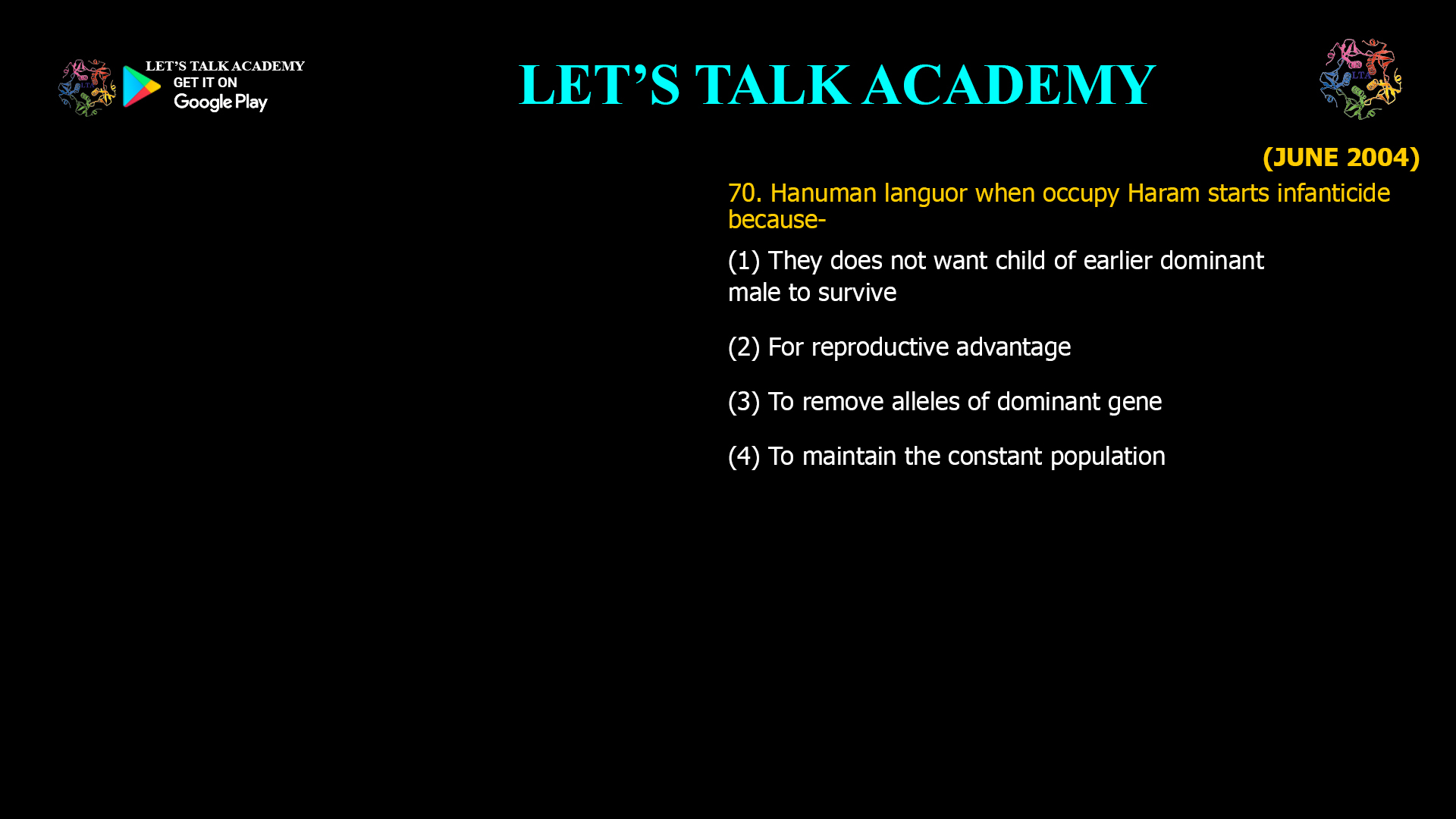- Hanuman languor when occupy Haram starts infanticide because-
(1) They does not want child of earlier dominant male to survive
(2) For reproductive advantage
(3) To remove alleles of dominant gene
(4) To maintain the constant populationThe Social Structure of Hanuman Langurs
Hanuman langurs, also known as gray langurs, live in complex social groups. The most common structure is the unimale-multifemale group, where one dominant male controls access to several females and their young. Other males form bachelor groups and challenge the dominant male for control. When a takeover occurs, the new male often kills the infants sired by his predecessor.
The Evolutionary Logic: Reproductive Advantage
The primary reason Hanuman langur males commit infanticide after taking over a harem is reproductive advantage. This behavior isn’t random or senseless violence; it is a calculated evolutionary strategy that increases the new male’s chances of passing on his genes. Here’s how it works:
1. Accelerating Female Fertility
Female langurs do not ovulate while they are nursing their infants. As long as a female is lactating, she is not available for mating. By eliminating the existing infants, the new male ends the lactation period, causing the females to return to estrus (fertility) much sooner. This allows the new male to mate with the females and sire his own offspring quickly, maximizing his reproductive window before another male might challenge him.
2. Eliminating Rival Genes
By killing the offspring of the previous dominant male, the new male ensures that only his genetic material is passed on to the next generation. This is a direct way to remove the genetic legacy of his predecessor and secure his own reproductive success.
3. Short Tenure, High Stakes
Male Hanuman langurs rarely hold onto a harem for long periods. The constant threat of being challenged means the new male must act quickly to maximize his reproductive output. Infanticide is a brutal but effective way to ensure that he fathers as many offspring as possible during his short reign.
Dispelling Common Misconceptions
Let’s address some of the other proposed reasons for infanticide and why they are less accurate:
-
Maintaining Constant Population: Infanticide is not a population control mechanism. The primary driver is individual reproductive success, not group-level population management.
-
Removing Dominant Alleles: The act is not about removing specific genes or alleles from the population. It is about maximizing the reproductive output of the new male, regardless of the genetic makeup of the infants.
-
Aggression or Malice: While the behavior appears violent, it is not driven by malice but by evolutionary pressures and natural selection.
Female Counterstrategies
Female Hanuman langurs are not passive victims in this process. Over generations, they have evolved several strategies to protect their offspring:
-
Direct Defense: Mothers may attempt to physically defend their infants, sometimes with the help of other females.
-
Deceptive Mating: Females may mate with the new male even before their infants are killed, creating confusion over paternity and reducing the risk of infanticide.
-
Coalition Building: Females may form alliances to collectively resist the new male, though this is not always successful.
Despite these strategies, the new male’s drive for reproductive advantage often prevails, especially if he is significantly stronger or more aggressive than the females.
The Impact on Hanuman Langur Society
Infanticide has a profound impact on the social structure and reproductive strategies of Hanuman langurs:
-
Short Male Tenures: The constant threat of takeovers leads to high male turnover rates.
-
Female Philopatry: Females tend to remain in their natal groups, while males move between groups.
-
Behavioral Adaptations: Both males and females have evolved complex behaviors to navigate the risks and opportunities presented by infanticide.
Comparison with Other Species
While infanticide after harem takeover is most pronounced in Hanuman langurs, similar behavior is observed in lions and some other primates. However, the frequency, social context, and evolutionary pressures differ. In lions, for example, new males may kill cubs after taking over a pride, but the social dynamics are not identical to those of langurs.
Conservation and Ethical Considerations
Understanding the evolutionary logic behind infanticide is crucial for conservation efforts. Human interference, habitat loss, and changes in group structure can disrupt the natural balance, sometimes increasing the frequency of takeovers and infanticide. Conservationists must consider these dynamics when managing populations and habitats.
Conclusion
Infanticide among Hanuman langurs following a harem takeover is a classic example of evolution in action. The primary reason for this behavior is reproductive advantage—the new male increases his chances of passing on his genes by eliminating the offspring of his predecessor and bringing females back into estrus. While this behavior may seem harsh, it is a natural result of the intense competition for reproductive success in the animal kingdom.
-




1 Comment
Kajal
October 15, 2025Reproductive advantage